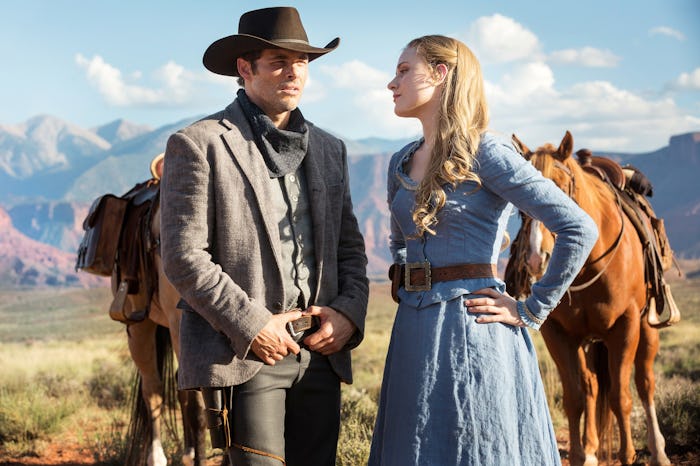Entertainment

HBO's 'Westworld' Vs. The 'Westworld' Movie Shows Time Has Improved An Old Idea
Though HBO's Westworld has the feel of something wholly original, it's not actually a new story. The themes at its heart are ones that come up again and again in science fiction: technology versus humanity, what makes us human, artificial intelligence, violence as entertainment, and seemingly safe environs going horrifically wrong. They're all trademarks of futuristic stories. It isn't a surprise that Westworld deals with all of these things because the 1973 movie its based on also explored many of the same ideas. But comparing HBO's Westworld vs. the Westworld movie shows just how much this story has evolved over forty years.
Westworld (1973) was one of many dystopic films that came out in the 70s and explored the dark turns the world might take as technology and human arrogance grew. The ideas at its core were fascinating and while the movie might not hold up as well in today's day and age, it has provided long-reaching inspiration. Writer and director Michael Crichton took the basic premise of a theme park gone wrong and wrote mega-hit Jurassic Park, and many other now-familiar themes were still in their early stages around the time of Westworld's release. However, there are more differences than similarities when comparing the movie to the television show. The series takes the film's themes and it explores them in a new way, bringing thoughtfulness and intricacy to something audiences have seen before.
Same: The Premise
The basic premise of both the series and the movie are the same: they're both set in a Wild West themed amusement park with incredibly realistic humanoid robots who begin to malfunction as times goes on. The guests spend an exorbitant amount of money to go there and indulge in their deepest, darkest fantasies – no matter how violent or sexual.
Different: The Worlds
In the 1973 film, Westworld is one of three amusement parks offered by the Delos company. The other two are Romanworld and Medievalworld, which are explored onscreen as the virus affecting the robots spreads throughout all of the parks. The TV show could choose to explore different types of parks as time goes on, but as of right now it has a more singular focus.
Same: New Visitors
The main plot of the film follows two men who are visiting Westworld: John, a longtime visitor, and his friend Peter, a newbie to the park. It looks like Episode 2 of the series will take on a similar storyline as it introduces Logan, a longtime visitor, and his friend William, a first timer.
Different: Gunslinger vs. the Man in Black
Perhaps the biggest change is the character of the Gunslinger. As played by Yul Brynner in the film, he's a duel-starting robot who goes off the rails and gains the ability to harm the guests. He goes on something of a killing spree before being stopped by Peter. In the HBO series, Ed Harris' the Man in Black takes clear inspiration from the Gunslinger with one major change: he's not a robot. Instead he's another guest, one who has played the game for so long he's now starting to dismantle the world as he searches for more. Some feel there may be a twist coming where he is revealed to be a robot, but as of right now all signs point towards human.
Same: Hands
It's a small detail, but the HBO series does make a nod to the original when it comes to the robots' hands. In the film, a guest remarks that "they haven't perfected the hands yet," noting that it's one way to tell that the robots aren't quite human. While that isn't a problem with the current iteration of robots on the series, they do mention that the older models also had imperfect hands.
Different: Women
The film doesn't have any female characters in the main cast, and the few supporting ones that appear don't get much to do. There's one very brief glimpse of a female guest, but most of the guests appear to be men. The female robots basically exist to be sexual objects. The TV series actually devotes quite a lot of time to its female characters, giving them deeper inner lives and actual personalities.
Same: Guests vs. Hosts
Obviously a large part of the premise rests on the interaction between guests and hosts. Both film and television focus on the introduction of new, human characters into a world populated by long-running robots. However, they do so in totally different ways.
Different: Point of View
While the movie focuses on the humans and uses the robots primarily as set dressing, the show changes the focus. The robots become the point of view characters as the audience sees their stories through their eyes. It's clear the show intends to make them sympathetic characters and the change in point of view encourages the audience to empathize with them instead of the much more insensitive humans.
The series also gives more development to the creators and technicians of the theme park. While the behind the scenes crew is featured in the movie, they don't receive the same level of personalization as they do in the show.
Many of the differences from film to show are thanks the change of medium. Television allows for a lot more time to develop characters than an hour and a half film does. Time can account for the rest; something that would have been cutting edge in the 70s is far from it in 2016, so the show has necessarily evolved along with modern sensibilities. Most of all, the HBO series has given Westworld a new richness and depth that tackles the themes of the old movie with much more effectiveness.